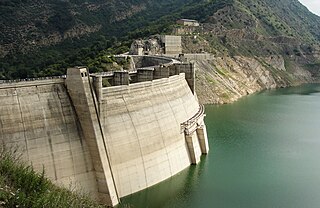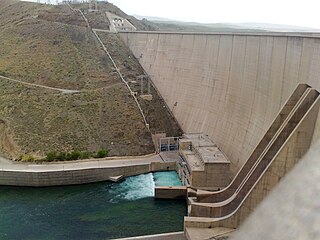Related Research Articles

The Karun-3 dam is a hydroelectric dam on the Karun river located in the province of Khuzestan, Iran. It was built to help meet Iran's energy demands as well as provide seasonal flood control. The Karun river has the highest discharge slits and seasonal flooding in Iran.

The Karun is the Iranian river with the highest water flow, and the country's only navigable river. It is 950 km (590 mi) long. The Karun rises in the Zard Kuh mountains of the Bakhtiari district in the Zagros Range, receiving many tributaries, such as the Dez and the Kuhrang. It passes through the city of Ahvaz, the capital of the Khuzestan Province of Iran, before emptying to its mouth into Arvand Rud.

The Kajaki Dam is "an earth and rockfill embankment type dam" located on the Helmand River in the Kajaki District of Helmand Province in Afghanistan, about 161 km (100 mi) northwest of Kandahar. It has a hydroelectric power station, which is operated by the Helmand and Arghandab Valley Authority through the Ministry of Energy and Water.

The Karun-4 Dam is an arch dam on the Karun River located 180 km southwest of Shahr-e-Kord in the province of Chaharmahal and Bakhtiari, Iran. The Karun has the highest discharge of all the Iranian rivers. Its construction is aimed at generating hydroelectric power supply of 2,107 million kWh annually and controlling floods in the upper Karun.
The Meghri hydroelectric project is a hydroelectric project planned on the Aras River near Armenia's southern town of Meghri on the Armenia–Iran border.

The Masjed Soleyman Dam is a dam in Iran on the Karun river. It is 177 metres (581 ft) high, has an installed capacity of 2,000 MW, and its reservoir holds 261,000,000 cubic metres (212,000 acre⋅ft) of water. The dam is a rock-fill structure with a vertical clay-core. The dam was built by Iran Water and Power Resources Development Co. and completed in 2002. The power station was built in two 1,000-MW stages. The first stage was complete in 2003 and the second in September 2007. The dam was named after the town of Masjed-Soleyman, about 25 kilometres (16 mi) away. The spillway gates are believed to be the largest of their kind in the world.

Shahid Rajaee Dam, also known as the Soleyman Tangeh Dam, is an arch dam on the Tajan River, located about 38 km (24 mi) south of Sari in Mazandaran Province, Iran. The dam was built for hydroelectric power production, flood control and to provide water for industrial and agricultural use. Construction on the dam began in 1987 and it was complete in 1997. In 2000 the power plant portion of the project was given to Iran Water & Power Resources Development Co. from the Mazandaran Regional Water Authority. An earthquake halted the project in 2002 but the power plant was completed in 2007.
The Kouhrang 2 Hydroelectric Power Station is located just south of Chelgard and about 69 km (43 mi) northwest of Shahrekord in Chaharmahal and Bakhtiari Province, Iran. The power station has an installed capacity of 33.3 MW and uses water diverted to the east from the Kouhrang River, via a small dam and the 2 km (1.2 mi) long Kouhrang 2 Tunnel, to produce power. Water from the Kouhrang is stored in a circular dam before being sent to the power station. The power station's three generators were commissioned between 2002 and 2004, the power plant were inaugurated in February 2005. Water discharged from the power station enters the Zayandeh River as part of a larger project to provide water to major cities like Isfahan. The intake for the power plant is located on the Kouhrang River just downstream of the Kouhrang 1 Dam which also diverts water, via the 2,800 m (9,200 ft) long Kouhrang 2 Tunnel, to near Chelgard and was completed in 1953. The Kouhrang 3 Dam is planned downstream to regulate river flows and divert more water to the Zayandeh via the Kouhrang 3 Tunnel.

Rudbar Lorestan Dam is a hydroelectric dam on the Rudbar River, a tributary of the Dez River, in Iran's Lorestan Province with an installed electricity generating capability of 450 MW. It was scheduled to become operational in 2013. Finally, the dam was completed on September 15, 2016. The hydroelectric plant consisting of two 225-MW vertical Francis turbine-generator units has begun operating on May 31, 2017.

Upper Gotvand Dam, or simply the Gotvand Dam, is an embankment dam on the Karun River about 12 km (7.5 mi) northeast of Gotvand in Khuzestan Province, Iran. It currently has an installed capacity of 1,000 MW with another 1,000 MW in the works for a second phase. Studies for the project on Karun River began in the 1960s and specific designs on the Upper Gotvand were presented in 1967, 1975 and 1982. After the design and location were chosen, a further study was carried out in 1997. Preliminary construction began the same year. Besides the hydroelectric power production, the dam was also aimed at flood control. The river was diverted by April 2003 and excavation began soon thereafter. After completion of the dam, impounding of its reservoir began on 30 July 2011 during a ceremony attended by Iranian President Mahmood Ahmadinejad. The first generator of phase one was commissioned on 5 May 2012, two more by 18 September 2012 and the final in November 2012. Ahmadinejad was again present for the dam's inauguration on 22 April 2013. Phase 2 is estimated to be complete in 2015 and the dam is going to become one of Iran's largest power stations and is already its tallest earth-fill dam.
Khersan-3 dam is a hydroelectric arch dam currently under construction on the Khersan River, a tributary of the Karun River, in Iran. When complete it will have an installed capacity of 400 MW. It is situated near Atashgah in Chaharmahal and Bakhtiari Province and is a complementary dam to Khersan project along with the proposed Khersan-1 and Khersan-2 dams. Construction began in 2007 and it is expected to become operational in 2015.

Sefidrud Dam is a buttress dam on the Sefīd-Rūd in the Alborz mountain range, located near Manjil in Gilan Province, northern Iran.

Khoda Afarin Dam is an earth-fill embankment dam on the Aras River straddling the international border between Iran and Azerbaijan. It is located 8 kilometres (5.0 mi) west of Khomarlu in East Azerbaijan Province, Iran and 14 kilometres (8.7 mi) southwest of Soltanlı in Jabrayil District, Azerbaijan. Armenian de facto protectorate Republic of Artsakh occupied the area in 1993, during the First Nagorno-Karabakh War, but on 18 October 2020, the Azerbaijani forces retook control of the dam during the 2020 Nagorno-Karabakh conflict. It is located 1 km (0.62 mi) upstream of the Khudafarin Bridges.

Zayanderud Dam, also spelled Zayandeh Rud Dam formerly known as the Shah Abbas Dam, is an arch dam on the Zayandeh River about 10 km (6.2 mi) east of Chadegan, Iran. The Zayanderud Dam is the main water reservoir with 1450 MCM capacity and has been exploited since 1971. The Zayanderud has provided the needs of water for important economic activities including agricultural, industrial and domestic consumptions. The primary purpose of the dam is water supply to Isfahan which lies 88 km (55 mi) to the east. It also supports a power station with an installed capacity of 55 MW. In recent years, the Zayandeh River has experienced significant reductions in flow due to a combination of drought, climate change, and overuse of water resources.

Rais Ali Dilavari Dam is a hydroelectric dam in Iran with an installed electricity generating capability of 70 MW. It is situated in Shabankareh, Bushehr Province.

Doroodzan Dam is an earthen dam in Fars province, Iran, about 85 kilometres (53 mi) north of Shiraz. Completed in 1974 and built primarily for irrigation water storage, flood control, and municipal water storage, the facility is also a hydroelectric dam with an installed electricity generating capability of 10 MW.

Marun Dam , also spelled Maroun, is a rock-fill embankment dam on the Marun River about 15 km (9.3 mi) north of Behbahan in Behbahan County, Khuzestan province, Iran. The dam serves to provide water for irrigation and to generate hydroelectric power as well. Construction on the dam began in 1989 and it was completed in 1998. A smaller Marun-II regulator dam is planned downstream. The 150 MW power station was commissioned in 2004.

Gavshan Dam is an embankment dam on the Gaveh River 40 km (25 mi) south of Sanandaj in Kurdistan province, Iran. It was created for the primary purpose of irrigation but also supports an 11 MW hydroelectric power station. Water from the dam's reservoir is transferred for irrigation in Kurdistan and Kermanshah provinces via 20 km (12 mi) Gavshan Water Conveyance Tunnel. About 189,000,000 m3 (153,225 acre⋅ft) can be transferred annually for the irrigation of 310 km2 (120 sq mi). Additionally, water from the reservoir is used to provide drinking water for the city of Kermanshah in the amount of 63,000,000 m3 (51,075 acre⋅ft) annually. Construction on the dam began in 1992 and was completed in 2004. It was inaugurated by Iran's President Mohammad Khatami on 13 February 2005.
Tarik Dam is a dam on the Sefīd-Rūd river in the Alborz mountain range, about 32 km (20 mi) south of Rasht in Gilan Province, northern Iran.

The Daryan Dam, also spelled Darian, is an embankment dam constructed on the Sirvan River just north of Daryan in Paveh County, Kermanshah province, Iran. The primary purpose of the dam is to supply up to 1,378,000,000 m3 (1,117,000 acre⋅ft) of water annually to the 48 km (30 mi) long Nowsud Water Conveyance Tunnel where it will irrigate areas of Southwestern Iran. The dam also has a 210 MW hydroelectric power station. Construction on the dam began in 2009 and the dam began to fill its reservoir in late November 2015. The Darian Dam Archaeological Salvage Program (DDASP) was planned by Iranian Center for Archaeological Research before flooding the reservoir. As a result, a number of important archaeological sites were discovered and some were excavated. The power station was commissioned in 2018. The dam's diversion tunnel was completed in June 2011. The dam was designed by Stucky of France and consultation was provided by Mahab Ghodss, International Consulting Engineering Co. In August 2010 Farab Co. won the contract to build the power station. In 2011, workers on the project held a protest against unpaid wages. The dam is also the subject of protest due to the forced relocations and ecological/cultural impact its reservoir will have.
References
- ↑ "Home – Iran Water and Power Resources Development Co". en.iwpco.ir. Archived from the original on 2008-12-05.
- ↑ "New Page 1". Archived from the original on 2008-06-17. Retrieved 2010-04-24.
